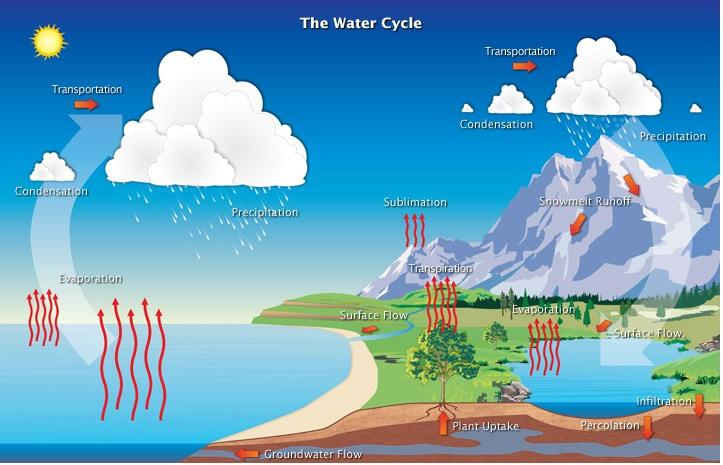
What is transpiration in the water cycle?
Answer
407.1k+ views
1 likes
Hint: Water is an inevitable need in our daily life. Water cycle is the phenomenon which exhibits the movement of water from place to place. There are different water sources on our planet namely, oceans, seas, rivers, lakes, ponds etc. Water evaporated from plants is also a contribution to the water cycle.
Complete answer:
Transportation of water and food is considered important for the growth of plants. Plants mainly get their water from the soil which is absorbed with the help of roots. The absorbed water reaches other parts of the plant through vascular xylem present in the cells. Water from the leaves in the form of vapor is released to the atmosphere. This process is known as transpiration. Transpiration occurs with the help of stomata. Stomata are tiny pores present on the surface of the leaves. Guard cells are in-charge of opening and closure of stomata.

Transpiration is essential in the water cycle as it acts as an important source. About
Additional information:
Water cycle, also known as hydrological cycle, is a biogeochemical cycle that aids in the regulation and maintenance of water on the planet. It includes evaporation of water from different water bodies, condensation of water in the form of clouds and precipitation in the form of rain and snow.
Note:
Plants contribute to the water cycle through the process of transpiration. The rate of transpiration is higher in the morning and lower at night because stomata opens mainly during the day time. Transpiration rate can be affected by temperature, humidity, wind movement and moisture content of the soil.
Complete answer:
Transportation of water and food is considered important for the growth of plants. Plants mainly get their water from the soil which is absorbed with the help of roots. The absorbed water reaches other parts of the plant through vascular xylem present in the cells. Water from the leaves in the form of vapor is released to the atmosphere. This process is known as transpiration. Transpiration occurs with the help of stomata. Stomata are tiny pores present on the surface of the leaves. Guard cells are in-charge of opening and closure of stomata.

Transpiration is essential in the water cycle as it acts as an important source. About
Additional information:
Water cycle, also known as hydrological cycle, is a biogeochemical cycle that aids in the regulation and maintenance of water on the planet. It includes evaporation of water from different water bodies, condensation of water in the form of clouds and precipitation in the form of rain and snow.
Note:
Plants contribute to the water cycle through the process of transpiration. The rate of transpiration is higher in the morning and lower at night because stomata opens mainly during the day time. Transpiration rate can be affected by temperature, humidity, wind movement and moisture content of the soil.
Recently Updated Pages
Master Class 9 General Knowledge: Engaging Questions & Answers for Success

Master Class 9 English: Engaging Questions & Answers for Success

Master Class 9 Science: Engaging Questions & Answers for Success

Master Class 9 Social Science: Engaging Questions & Answers for Success

Master Class 9 Maths: Engaging Questions & Answers for Success

Class 9 Question and Answer - Your Ultimate Solutions Guide

Trending doubts
Where did Netaji set up the INA headquarters A Yangon class 10 social studies CBSE

A boat goes 24 km upstream and 28 km downstream in class 10 maths CBSE

Why is there a time difference of about 5 hours between class 10 social science CBSE

The British separated Burma Myanmar from India in 1935 class 10 social science CBSE

The Equation xxx + 2 is Satisfied when x is Equal to Class 10 Maths

Chandigarh is the capital of A Punjab B Haryana C Punjab class 10 social science CBSE




